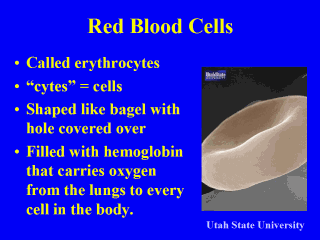| front |1 |2 |3 |4 |5 |6 |7 |8 |9 |10 |11 |12 |13 |14 |15 |16 |17 |18 |19 |20 |21 |22 |23 |24 |review |
 |
Red Blood
Cells: The Oxygen Carriers Red Blood Cell (RBC) Count: RBCs are produced in your bone marrow and carry oxygen through the body. The RBC count is the number of red blood cells produced in about 20 drops of blood (cubic milliliter). Normal RBC levels range from 4.5-6.1 million per cubic milliliter for men, and 4.0-5.3 million for women. Many people with HIV may have values below the normal range. Slightly decreased values should not be cause for alarm. However, greatly reduced numbers can be a sign of anemia and should be carefully examined and treated if necessary. Symptoms include fatigue, shortness of breath, pale skin color and, in women, menstrual irregularities. Anemia can be caused by certain medications or illness. Low RBC counts are accompanied by lower hemoglobin and hematocrit levels. Hemoglobin: Hemoglobin is a protein in RBCs that carries oxygen to the body. Normal hemoglobin levels are 12-16 grams per deciliter (g/dl) in women and 14-18g/dl in men. People with HIV often have lower than normal hemoglobin levels, usually due to a decline in the number of RBCs produced by the bone marrow. Drugs that cause bone marrow suppression will also lower hemoglobin counts. People with HIV who have mild anemia sometimes take iron supplements or erythropoietin (Epogen), a hormone that stimulates the production of RBCs to increase hemoglobin counts. If anemia is severe, however, erythropoietin therapy should not replace a blood transfusion. Hematocrit: The hematocrit is another way to measure red blood cell numbers. It is the percentage of blood cells in your body which are red blood cells. Normal values range from 40-54% in men and 37-47% in women. Hematocrit values indicate the thickness of the blood as well as its oxygen-carrying capacity. A low hematocrit is another indicator of anemia. |